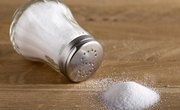
When you’re in the lab, you need to work with many different solutions. In order to make a solution with the correct concentration, you need to know how much of a given compound you are adding.
Say you need to make a solution of 1M NaCl for a reaction you are running. How would you know how much salt to weigh out and then add to a given volume of water?
To do this, you need to find a way to relate the mass of a compound (salt) to the number of moles of that compound. The molar mass of elements tells you the molar mass of a compound, so you can figure this out.
Molar Mass Definition
The molar mass definition is the grams of a substance that are found in one mole of a substance. Thus, the units are grams per mole or g/mol.
What is a mole of a substance? A mole of a substance is a specific quantity of that substance.
A mole is a number: 6.022 x 1023. Since particles of a compound are so small, you can’t really talk about them individually without it becoming really cumbersome. For that reason, scientists make use of the mole. It describes a huge number of molecules. Grams per mole thus describes the mass of an element when there are one mole particles of that substance.
Now that you know what a mole is and what molar mass refers to, where do you find this number? You can find it for each element on the periodic table. If you look underneath the symbol for each element, you will find a number. The molar mass of elements is given by that number, molar mass, which is also the molecular weight.
Molar Mass Examples
The number under oxygen is 15.999 (take a look at a periodic table online or in your textbooks). The molar mass of oxygen is 15.999 g/mol.
What about the molar mass of a compound, not just an element?
To find the molar mass of a compound, you need to add the molar mass of all the elements in that compound.
Take a look at NaOH which contains sodium, oxygen and hydrogen. The molar mass of sodium is 22.99 g/mol, oxygen is 15.999 g/mol, and hydrogen is 1.008 g/mol.
Adding them together yields:
As such, the molar mass of NaOH is 30.997 g/mol.
What if you have a compound that has an element with a subscript? For example, MgCl2?
In this case you would need to add the molar mass of magnesium and two times the molar mass of chlorine:
So the molar mass of MgCl2 is 95.211 g/mol.
Using Molar Mass
Now, you can tackle the question at the beginning of the article. Say you need to make 1 L of a 1M NaCl solution. How do you know how much salt to weight out?
First, you will need to find the number of moles you need for this solution. To do this, you will need to make use of the desired molarity and the volume of desired solution.
This calculation means that you need one mole of salt. Now, you need to use the molar mass of salt in order to calculate how much you need to weigh out.
This calculation means that if you wanted to make a 1 liter solution of 1M NaCl, you would need to weigh out 58.44 grams of NaCl. You would add this 58.44 grams of salt to a graduated cylinder and fill it up until the 1 liter mark.
References
Tips
- Write everything down in an organized fashion to ensure you don't make mistakes. Don't try to figure out molar mass in your head, or you are likely to make an error.
Warnings
- Be careful when calculating compounds that have dual subscripts. For example, if you have (PO4)2, you would be calculating two atoms of phosphorus and eight atoms of oxygen.
About the Author
Riti Gupta holds a Honors Bachelors degree in Biochemistry from the University of Oregon and a PhD in biology from Johns Hopkins University. She has an interest in astrobiology and manned spaceflight. She has over 10 years of biology research experience in academia. She currently teaches classes in biochemistry, biology, biophysics, astrobiology, as well as high school AP Biology and Chemistry test prep.
Photo Credits
molecule image by Oleg Verbitsky from Fotolia.com
